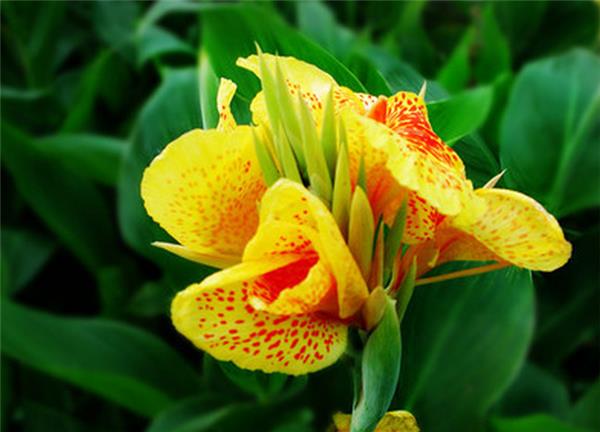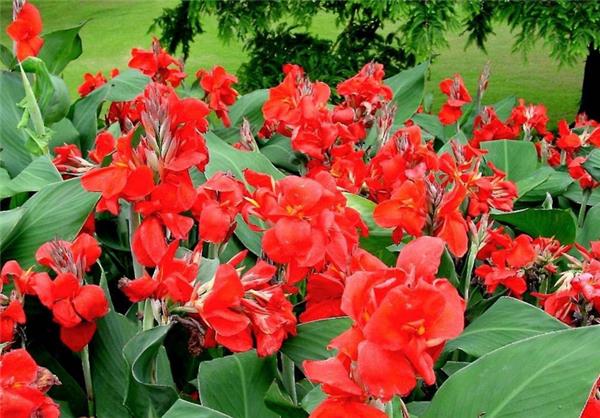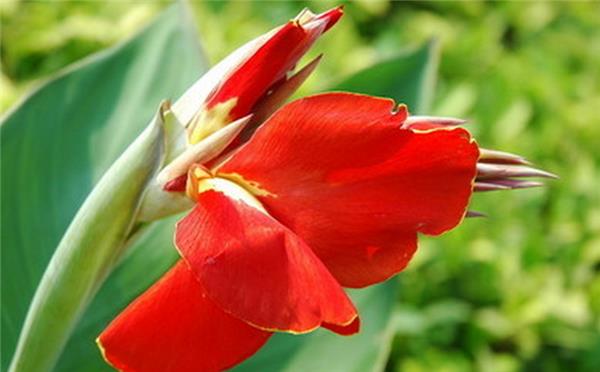Introduction of Canna and how to cultivate Beautiful Canna
Canna is a kind of ornamental plant, because its beautiful appearance has the function of decorating home, so what is the introduction of Ke Mei, and what is its planting method? Let's have a look together.

Canna, also known as "red banana", "Tanhua" and so on, is a large flower. Buddhism believes that canna is made from blood shed from Buddha's toes. The flower language of Canna is "solid future". Family Canna, native to tropical America and Africa. Banana is a perennial bulbous rhizome herb with stout, fleshy rhizomes lying in the ground. In the warm area, there is no dormant period, and it can grow annually, and it is most suitable to grow at the temperature of 22-25 ℃, and the growth will stop at 5-10 ℃, and freezing injury will occur when it is lower than 0 ℃. Because canna likes to be moist and avoid dryness, in hot summer, if it is hit by the hot sun or the dry and hot wind, the leaf edge will scorch; the same phenomenon will occur if it is overwatered. Canna likes warmth and plenty of sunshine and is not resistant to cold. The soil is required to be deep and fertile, and potted plants are required to have loose soil and good drainage. Fertilizers are often applied during the growing season. The plants are all green and can be up to 2 meters high. Leaf blade ovate-oblong, 10-30 cm long and 10 cm wide. Racemes sparsely flowered; slightly above leaves; flowers red, solitary; bracts ovate, green, ca. 1.2 cm long; sepals 3, lanceolate, ca. 1 cm, green and sometimes dyed red; Corolla tube less than 1 cm long, Corolla lobes lanceolate, 3-3.5 cm long, green or red Outer whorl staminodes 3-2, bright red, of which 2 are oblanceolate, 3.5-4 cm long and 5-7 mm wide, and the other, if present, is particularly small, 1.5 cm long and only 1 mm wide; labellum lanceolate, 3 cm long, curved; developmental stamens 2.5 cm long, anther chamber 6 mm long; style flattened, 3 cm long, half connate with filaments of developmental stamens. Capsule green, long ovate, with soft spines, 1.2-1.8 cm long. Flowering and fruiting period: March-December.

The culture method of canna:
1. Cultivation:
Canna is native to tropical regions such as America, India and Malay Peninsula. It is warm, moist and sunny, not hardy and afraid of strong winds and frosts. It is not strict with the soil, can withstand barren, and grows well in fertile, moist and well-drained soil. After the plant withered in late autumn, cut off the aboveground part, dig out the rhizome, air for 2-3 days, and bury it in the well-ventilated sand in the greenhouse. Do not water it and keep it above 5 degrees to survive the winter safely. In the south of the Yangtze River, the roots can not be dug out in winter, as long as they are sealed with soil, they can still sprout in the next spring.

2. Sowing and propagation:
The hard seed coat of the seed was cut with a sharp tool from April to May, soaked in warm water for one day and night, then sowed in open ground, sprouted 2-3 weeks after sowing, transplanted once when 2-3 leaves grew, and could blossom in the same year or the following year. It is a common material for shrub edge, flower diameter and flower mirror in gardens. It is suitable to choose dwarf varieties in potted plants. The basin soil is mixed with loam rich in organic matter and a small amount of river sand. Planting after late frost in spring, 1-2 plants per pot, watering enough water after planting, and keeping the pot soil moist, otherwise it will lead to scorched leaf edges and even sparse flowering. After the plant grew to 3-4 leaves, liquid fertilizer was applied every 10 days. Until it blossoms. Cut off the residual flowers in time after flowering to promote them to sprout new branches. Move to indoor maintenance in time before autumn frost. Canna likes hot and hot, so there is plenty of sunshine. Grow healthily in a deep, fertile soil rich in organic matter. Afraid of strong wind, not cold-resistant, once the frost, the aboveground stems and leaves are withered, leaving underground stems. You can spend the winter in the open field to the south of the Yangtze River. To the north of the Yangtze River, the underground stem should be dug up, overwintered in the cellar, and replanted the following year, avoiding waterlogging and dampness during storage, and preventing tuber from rotting.

3. Propagate with tubers:
Tuber propagation takes place from March to April. The old rhizome was dug out and divided into blocks. 2-3 buds were retained on each rhizome with roots, which were planted in soil with about 10cm depth, plant spacing was kept 40~50cm, and enough water was poured. When the new buds grow to 5-6 leaves, it is necessary to apply a rotten fertilizer so that they can blossom in the same year. When potted, low varieties are often selected, leaving 3 buds in each pot. After planting, the soil covered with 8~10cm is thick. Adequate sunlight is required during the growing period, and be sure to receive at least 5 hours of direct sunlight every day. The environment is too dark, lack of light, will delay the flowering period, like warmth, avoid severe cold, suitable for a long temperature of 16-30 ℃. When flowering, in order to prolong the flowering period, it can be placed in a place with low temperature and no sunlight, and the ambient temperature should not be lower than 10 ℃. After planting, the rhizome should be watered less before it grows new roots. The basin soil should be moist. The soil is too wet and rots easily. After the scape grows, it should be often watered to keep the basin soil moist. If there is a lack of water, it is easy to appear the phenomenon of "flowers in the leaves" after flowering. Watering should be reduced in winter, based on the principle of "dry and wet". In addition to applying sufficient base fertilizer before planting, thin cake liquid fertilizer should be applied 3 or 4 times a month in the peak growing season. If the scape is not produced 20-30 days before the scheduled flowering period, 0.2% potassium dihydrogen phosphate aqueous solution can be sprayed once to promote the flowering. If you want to blossom on May Day, cover the stored rhizome with soil mixed with a small amount of fertilizer in January. The ambient temperature is required to be 30 ℃ during the day and 15 ℃ at night. After 10 days, the rhizome can sprout. After sprouting, plant the rhizome with 2 or 3 buds into the basin to keep the basin soil moist and fertilize appropriately. There are buds in early April, pay attention to ventilation, "May Day" can blossom. In the cold area, after frosting twice and most of the stems and leaves are withered and yellow in autumn, the aboveground parts are cut off, the roots and stems are dug out, and the roots are properly dried and left indoors. The winter can be safely overwintered at a temperature of 5: 7 ℃. The warm land can live in the open field in winter without harvest, but it must be dug up and replanted after 2-3 years, and the planting scale can be expanded at the same time.
The above is the introduction and culture methods of canna. I hope I can help you.
After planting, the rhizome should be watered less before it grows new roots. The basin soil should be moist. The soil is too wet and rots easily. After the scape grows, it should be often watered to keep the basin soil moist. If there is a lack of water, it is easy to appear the phenomenon of "flowers in the leaves" after flowering. Watering should be reduced in winter, based on the principle of "dry and wet". In addition to applying sufficient base fertilizer before planting, thin cake liquid fertilizer should be applied 3 or 4 times a month in the peak growing season. If the scape is not produced 20-30 days before the scheduled flowering period, 0.2% potassium dihydrogen phosphate aqueous solution can be sprayed once to promote the flowering. If you want to blossom on May Day, cover the stored rhizome with soil mixed with a small amount of fertilizer in January. The ambient temperature is required to be 30 ℃ during the day and 15 ℃ at night. After 10 days, the rhizome can sprout. After sprouting, plant the rhizome with 2 or 3 buds into the basin to keep the basin soil moist and fertilize appropriately. There are buds in early April, pay attention to ventilation, "May Day" can blossom. In the cold area, after frosting twice and most of the stems and leaves are withered and yellow in autumn, the aboveground parts are cut off, the roots and stems are dug out, and the roots are properly dried and left indoors. The winter can be safely overwintered at a temperature of 5: 7 ℃. The warm land can live in the open field in winter without harvest, but it must be dug up and replanted after 2-3 years, and the planting scale can be expanded at the same time.
The above is the introduction and culture methods of canna. I hope I can help you.
- Prev

The breeding and nursing methods of magnolia make your home smell full of flowers.
The breeding and nursing methods of magnolia make your home smell full of flowers.
- Next

The efficacy and function of Aloe Vera is of great use in cultivating Aloe vera.
The efficacy and function of Aloe Vera is of great use in cultivating Aloe vera.
Related
- Wuhan Hospital Iron Tree Blooming Result Was Instantly Frightened by the Gardener Master
- Which variety of camellia is the most fragrant and best? Which one do you like best?
- What is the small blue coat, the breeding methods and matters needing attention of the succulent plant
- Dormancy time and maintenance management of succulent plants during dormancy
- Minas succulent how to raise, Minas succulent plant pictures
- What are the varieties of winter succulent plants
- How to raise succulent plants in twelve rolls? let's take a look at some experience of breeding twelve rolls.
- Attention should be paid to water control for succulent plants during dormant period (winter and summer)
- Watering experience of twelve rolls of succulent plants
- Techniques for fertilizing succulent plants. An article will let you know how to fertilize succulent plants.

